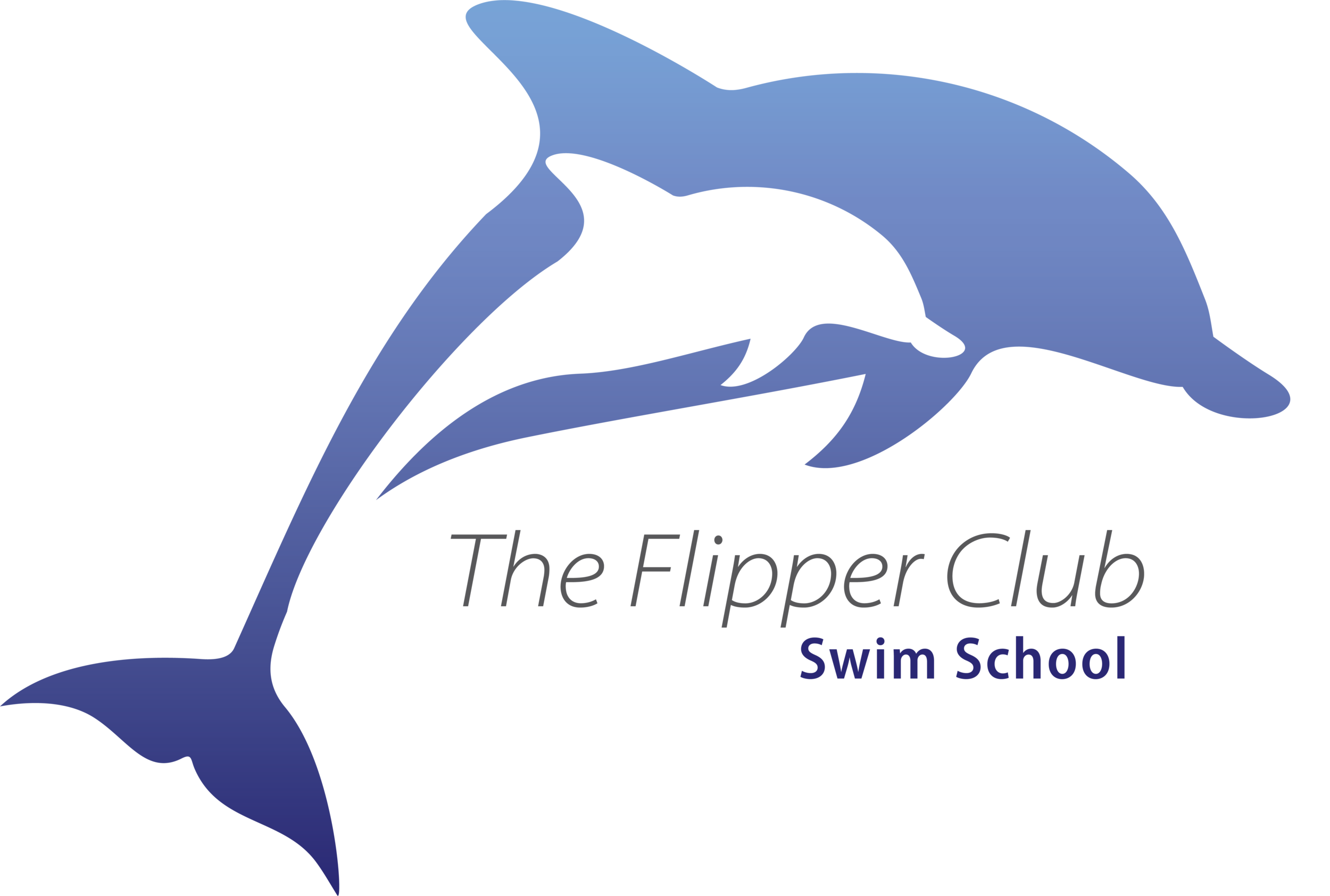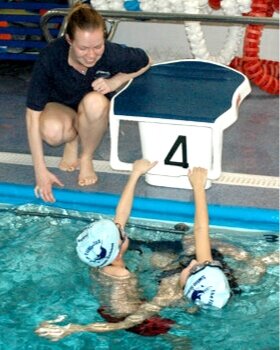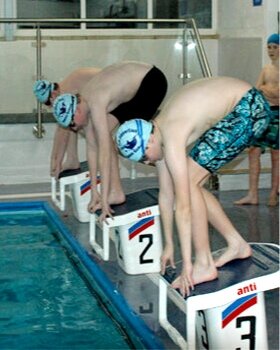Learn to Swim
Swim England Programme delivered by The Flipper Club
Stage 1
Swim England Learn to Swim Stage 1 helps to build water confidence, while introducing water safety skills and the basic skills needed to build swimming ability.
Learners will develop basic safety awareness, learn basic movement skills and water confidence skills.
They will also be introduced to a structured class setting. Swimmers may use flotation equipment, such as arm bands and floats, throughout this stage.
By completing the Learn to Swim Stage 1 Award, swimmers will be able to:
Enter the water safely.
Move forward for a distance of 5 metres, feet may be on or off the floor.
Move backwards for a distance of 5 metres, feet may be on or off the floor.
Move sideways for a distance of 5 metres, feet may be on or off the floor.
Scoop the water and wash the face.
Be comfortable with water showered from overhead.
Move from a flat floating position on the back and return to standing.
Move from a flat floating position on the front and return to standing.
Push and glide in a flat position on the front from a wall.
Push and glide in a flat position on the back from a wall.
Give examples of two pool rules.
Exit the water safely.
Stage 2
Swim England Learn to Swim Stage 2 sees swimmers develop streamlining to their strokes and travel without their feet on the floor, using a recognised leg kick.
Swimmers are also introduced to aquatic breathing and taught to make safe entries into the water, including jumping.
They will develop basic floating and learn how to rotate to regain an upright position without support. All travel must be achieved without the use of flotation equipment, though buoyancy aids may be used when swimmers aren’t travelling.
By completing the Learn to Swim Stage 2 Award, swimmers will be able to:
Jump in from poolside safely.
Blow bubbles a minimum of three times rhythmically, with nose and mouth submerged.
Move from a flat floating position on the back and return to standing without support.
Move from a flat floating position on the front and return to standing without support.
Push from a wall and glide on the back – arms can be by the side or above the head.
Push from a wall and glide on the front with arms extended.
Travel using a recognised leg action with feet off the pool floor on the back for 5 metres, without the use of floatation equipment.
Travel using a recognised leg action with feet off the pool floor on the front for 5 metres, without the use of floatation equipment.
Perform a tuck to rotate from a flat floating position on the front, to a back floating position, then return to standing.
Perform a tuck to rotate from a flat floating position on the back, to a front floating position, then return to standing.
Perform a log roll from the back to the front.
Perform a log roll from the front to the back.
Exit the water without support.
Stage 3
During Swim England Learn to Swim Stage 3, swimmers will develop their kicks, on both their front and their back.
They streamline through push and glides, whilst also swimming underwater.
Swimmers will develop safe entries into the water, including submersion, and travel up to 10 metres on their front and back. Water safety knowledge and rotation skills will also be progressed.
By completing the Learn to Swim Stage 3 Award, swimmers will be able to:
Jump in from poolside and submerge.
Sink, push away from wall and maintain a streamlined position.
Push and glide on the front with arms extended and log roll onto the back.
Push and glide on the back with arms extended and log roll onto the front.
Travel 5 metres on the front, perform a tuck to rotate onto the back and return on the back.
Fully submerge to pick up an object.
Correctly identify three of the four key water safety messages.*
Push and glide and travel 10 metres on the back.
Push and glide and travel 10 metres on the front.
Perform a tuck float and hold for three seconds.
Exit the water without using steps.
*The four key water safety messages include:
Always swim in a safe place.
Always swim with an adult.
If you fall in, float, breathe, relax.
If someone else in trouble, call 999/112.
Stage 4
Swim England Learn to Swim Stage 4 sees swimmers perfect their leg kicks for all four strokes and further develop push and glides, while also being introduced to sculling.
They will develop an understanding of buoyancy through a range of skills and should swim 10 metres to the Swim England Expected Standards.
By completing the Learn to Swim Stage 4 Award, swimmers will be able to:
Perform a sequence of changing shapes (minimum of three) whilst floating on the surface and demonstrate an understanding of floating.
Push and glide from the wall towards the pool floor.
Kick 10 metres backstroke (one item of equipment optional).
Kick 10 metres front crawl (one item of equipment optional).
Kick 10 metres butterfly on the front or on the back.
Kick 10 metres breaststroke on the front (one item of equipment optional).
Perform a head first sculling action for 5 metres in a flat position on the back.
Travel on back and log roll in one continuous movement onto front.
Travel on front and log roll in one continuous movement onto back.
Push and glide and swim 10 metres, choice of stroke is optional.
Stage 5
During Swim England Learn to Swim Stage 5, swimmers will develop their skills in treading water, learn the correct arm pulls for all four strokes and learn how to do handstands and somersaults.
This means they will develop their technique and perform all strokes to the Swim England Expected Standards.
The emphasis is on ensuring all work done in the previous stages is developed further.
By completing the Learn to Swim Stage 5 Award, swimmers will be able to:
Perform a flat stationary scull on the back.
Perform a feet first sculling action for 5 metres in a flat position on the back.
Perform a sculling sequence with a partner for 30-45 seconds to include a rotation.
Tread water for 30 seconds.
Perform three different shaped jumps into deep water.
Push and glide and swim 10 metres backstroke (performed to Swim England expected standards).
Push and glide and swim 10 metres front crawl (performed to Swim England expected standards).
Push and glide and swim 10 metres breaststroke (performed to Swim England expected standards).
Push and glide and swim 10 metres butterfly (performed to Swim England expected standards).
Perform a handstand and hold for a minimum of three seconds.
Perform a forward somersault.
Demonstrate an action for getting help.
Stage 6
Swim England Learn to Swim Stage 6 teaches swimmers how to prepare for exercise, while developing an efficient technique for all four strokes and further developing surface dives.
The effective swimming skills taught include coordination, breathing and an understanding of water safety.
Within this stage, swimmers will work on all the other strokes, including streamlining, improving their technique with both their arms and their legs.
By completing the Learn to Swim Stage 6 Award, swimmers will be able to:
Give two examples of how to prepare for exercise and understand why it is important.
Sink, push off on side from the wall, glide, kick and rotate into backstroke.
Sink, push off on side from the wall, glide, kick and rotate into front crawl.
Swim 10 metres wearing clothes.
Push and glide and swim front crawl to include at least six rhythmical breaths.
Push and glide and swim breaststroke to include at least six rhythmical breaths.
Push and glide and swim butterfly to include at least three rhythmical breaths.
Push and glide and swim backstroke to include at least six regular breaths.
Push and glide and swim 25 metres, choice of stroke is optional (performed to Swim England expected standards).
Perform a ‘shout and signal’ rescue.
Perform a surface dive.
Stage 7
Swim England Learn to Swim Stage 7 focuses on fully developing all four swimming strokes, as well as building stamina and improving diving skills.
Swimmers should develop a quality stroke technique for up to 100 metres, incorporating the skills they have learnt throughout the stages and combining them to develop a linked routine.
They should successfully complete an obstacle course, which combines a variety of skills they have learnt from Stages 1 to 7.
By completing the Learn to Swim Stage 7 Award, swimmers will be able to:
Push and glide and swim 25 metres backstroke (performed to Swim England expected standards).
Push and glide and swim 25 metres front crawl (performed to Swim England expected standards).
Push and glide and swim 25 metres breaststroke (performed to Swim England expected standards).
Push and glide and swim 25 metres butterfly (performed to Swim England expected standards).
Perform a movement sequence (linking skills with strokes and sculls) of one minute duration, in a group of three or more, incorporating a number of the following skills:
Sculling: head first, feet first
Rotation: forward or backward somersault, log roll
Floating: star on the front or on the back, tuck float, create own
Eggbeater: Moving, lifting one or both arms out of the waterPerform a sitting dive or dive.
Push and glide and swim 50 metres continuously using one stroke (performed to Swim England expected standards).
Push and glide and swim 100 metres, using a minimum of three different strokes (performed to Swim England expected standards).
Tread water using eggbeater action for 30 seconds.
Complete an obstacle course (using minimum of four objects) with feet off the pool floor throughout.
Stages 8 - 10
The Learn to Swim Stages 8-10 Awards make up the Aquatic Skills Framework of the Learn to Swim Programme.
Continuing beyond Swim Stage 7, swimmers are encouraged to take part in different aquatic disciplines that develop their fundamental sports skills including swimming, artistic swimming, water polo and diving, as well as, lifesaving activities through the RLSS Rookie Lifeguard Awards.
Stage 8
By completing this Award you will be able to:
Complete a set lasting 400 metres (e.g. 16 x 25 metres, 8 x 50 metres, 4 x 100 metres) on a specific turnaround time agreed by the teacher or coach (e.g. 1.00 minutes for each 25 metres) with a focus on stroke technique and consistency.
Swim 400 metres continuously using one stroke.
Push and streamline then kick 25 metres backstroke with or without using a board.
Push and streamline then kick 25 metres breaststroke with or without using a board.
Push and streamline then kick 25 metres butterfly without using a board.
Push and streamline then kick 25 metres front crawl with or without using a board.
Perform a backstroke turn from 10 metres in to 15 metres out.
Perform a breaststroke turn from 10 metres in to 15 metres out.
Perform a butterfly turn from 10 metres in to 15 metres out.
Perform a front crawl turn from 10 metres in to 15 metres out.
Perform a dive track or grab start, and kick butterfly underwater in a streamlined position for 5 metres with the focus on progressing it to 10 metres.
Stage 9
By completing this Award you will be able to:
Complete a set lasting 800 metres (either 16 x 50 metres, 8 x 100 metres, 4 x 200 metres) on a specific turnaround time agreed by the teacher or coach (e.g. 1.30 minutes for 50 metres) with a focus on stroke technique and consistency.
Swim 800 metres continuously using one stroke.
Swim a continuous 100 metre individual medley (4 x 25 metres) using recognised turns with a focus on stroke technique and consistency.
Perform a 15 metre underwater kick on front from a push and glide in a streamlined position.
Perform a backstroke start then butterfly kick in a streamlined position underwater up to a maximum of 15 metres from the start point (wall). Transfer into stroke and complete the remainder of the 25 metres.*
Perform a front crawl start then kick in a streamlined position underwater up to a maximum of 15 metres from the start point (wall). Transfer into stroke and complete the remainder of the 25 metres.*
Perform a butterfly start then kick in a streamlined position up to a maximum of 15 metres from the start point (wall). Transfer into stroke and complete the remainder of the 25 metres.*
Perform a breaststroke start then perform a one and a half pull underwater. Transfer into stroke and complete the remainder of the 25 metres.
Stage 10
By completing this Award you will be able to:
Complete a set lasting 1600 metres (either 16 x 100 metres, 8 x 200 metres, 4 x 400 metres) on a specific timed turnaround set by the teacher or coach (e.g. 2.30 minutes for 100 metres), focus on stroke technique and consistency.
Swim 1500 metres continuously using one stroke.
Perform a continuous 100 metre individual medley kick (4 x 25 metres) without using a kick board.
Swim a continuous 200 metre individual medley (4 x 50 metres) using recognised turns.
Perform a front crawl relay take over – as an incoming swimmer.
Perform a front crawl relay take over – as an outgoing swimmer.







